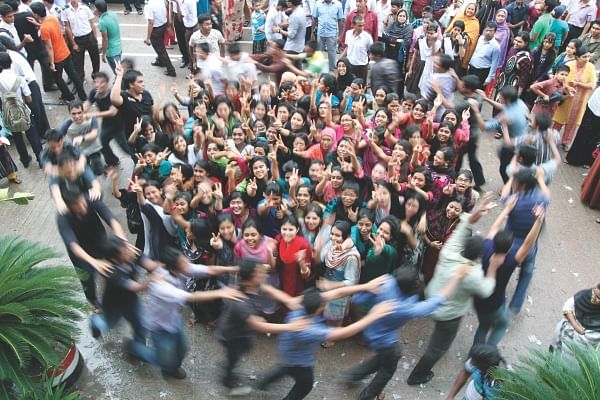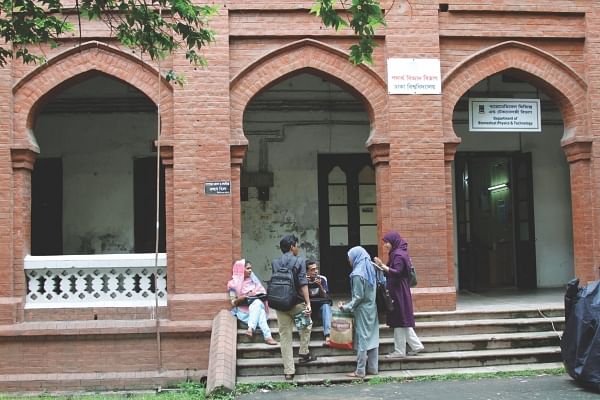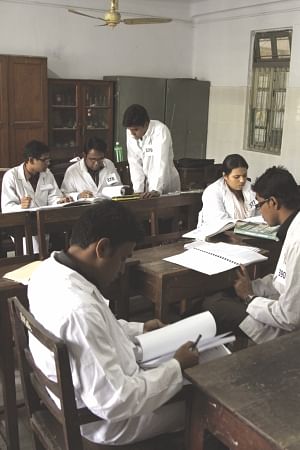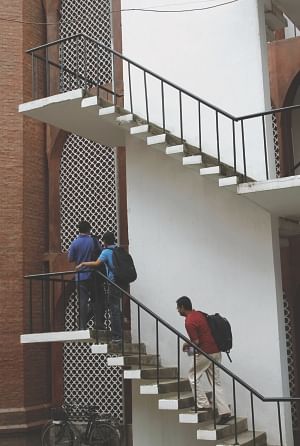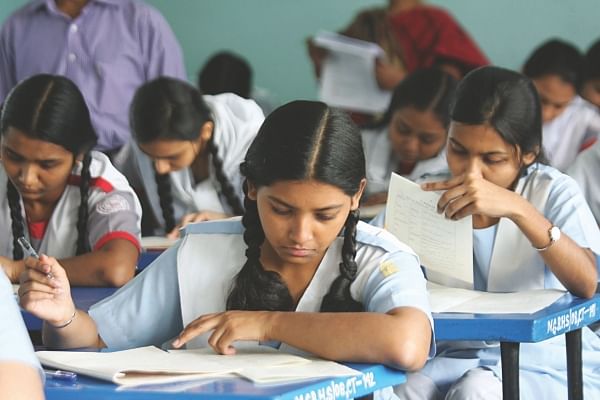| Home - Back Issues - The Team - Contact Us |
 |
| Volume 11 |Issue 31| August 03, 2012 | |
|
|
Cover Story All that Glitters is not Gold An outstanding number of HSC candidates have successfully completed their secondary education this year. They constitute the privileged few who now have access to the highest educational institutes in the country. But how accessible really is their future, given the shortage of seats, and the disparities that exist within the education system?
Sushmita S Preetha It is certainly a cause for celebration when our Higher Secondary Certificate (HSC) candidates produce record-breaking results. The pass rate this year in eight education boards was a whopping 76.5 percent – 4.14 percent higher than that of last year. Meanwhile, 51,469 students scored GPA-5, the highest grade point average in the country. For these radiant young minds, many of whom come from rural areas or underprivileged backgrounds, it seems as if the possibilities are now endless. Unfortunately, however, the mass success stories of recent years' results have exposed an inconvenient truth about our tertiary education system – its inability to accommodate the vast number of students who have the required grades to enrol in the public institution of their choice. “I want to become a doctor,” says Shumona Akhtar Dina, a recipient of GPA-5 from Dhaka. “But who knows if I will actually get a chance to get into medical school, given the intense competition,” states Dina, whose father is a chauffeur and hence cannot afford to send her to a private institution if all else fails. It's a similar concern for Sajedur Rahman, another GPA-5 recipient from Baghmara, Rajshahi, whose father is a rong mistri (house painter).
Dina and Sajedur are among the 30,123 students who scored a GPA-5 in their HSC examinations in Science alone. However, there are only 2,712 seats in the 18 public medical colleges around the country, and 1000 seats in Bangladesh University of Engineering and Technology (BUET). That means the vast majority of GPA-5 holders will have to settle for institutions that lack quality and prestige, if they get admitted at all. The situation is the same for the 6, 423 students in Humanities and 14,923 students who received a Golden GPA. According to the University Grants Commission (UGC), there are around 5,500 seats in Dhaka University, 3,200 seats in Rajshahi University, 4,000 seats in Chittagong University, 1,700 seats in Jahangirnagar University and 900 seats in Bangladesh Agricultural University. The number of seats in the public universities is certainly not enough to cater to the demands of students, especially when one considers that it won't just be the GPA-5 holders competing for a space in the esteemed institutions. Students with GPA 3.5 and above are eligible to apply to these universities. “I feel a sense of dread every time I think of the admission process,” says Reshmi Khanam, who scored a 4.5 in her exams. As the only person from her family to have studied till her intermediate, Reshmi was very happy with her results until she realised just how fierce the competition would be. “How am I supposed to compete with all these people? I read that more than 25,000 students got GPA 5 from Dhaka alone. How will a girl from a mufassil area possibly beat those chances?” asks a worried Rehana. In response to the growing concern over shortage of seats, Education Minister Nurul Islam Nahid says that the government is doing all it can to meet the increasing demand. “We have given permission for 4 new public universities and 8 private universities. We have created opportunities for completing honours in degree colleges, and we have also appointed new teachers. Compared to last year, a lot of seats have increased.” Nahid is confident that every student who wants to study further will get the chance to do so. “You will not be able to bring me a student who couldn't get admitted into any educational institution in the country after all the admission processes are over. But the real question is: will they be able to get admitted in the institution of their choice? Perhaps not. But then again, there's no guarantee in any part of the world that a student will get admitted to his/her institution of choice – otherwise everyone could study in Oxford and Cambridge,” opines the Minister. For all those who cannot get admitted into a public university of his/her choice, there are about 200,000 seats available for Honours and an additional 90,000 seats available for degree courses under the National University as possible fallback options. However, despite the visible shortage of seats over the years, many of these national colleges, especially in rural areas, don't get enough students. The quality of education within these 1,800 institutions, for the most part, is deplorable, with incompetent teachers, inadequate infrastructure and outdated curricula. In addition, corruption, internal politics and session jams plague the lives of most National University students as is apparent in the recent student protests against session jams and the High Court ruling to dismiss the appointments of around 1,100 employees of National University on account of irregularity and nepotism. Kazi Nazmus Shahadat, a student of Tejgaon College, currently a third year student, says that he was supposed to graduate by now. “At this rate, I won't graduate till 2014 – a waste of at least three years of my life. It takes 2 to 2.5 years to complete a Master's course that should take a year, and 6-7 years to complete Honours.”
Shahadat works part-time in Banglalink and admits that most students of his college do not come to class on a regular basis. “Everyone is so frustrated with the way things are run. We see other people of our age having full-time jobs in respectable places while we are still struggling to finish our honours. Everyone has lost interest in education,” he adds. The condition of these institutions is a matter of grave concern, especially when one considers that over three quarters of the tertiary education students study there. These institutions, rather than the universities, supply the vast majority of the higher level technical-professional manpower of the country, including school and college teachers, engineers, doctors, lawyers and employees and managers in the public sector, the government agencies and private businesses and enterprises. As Dr Manzoor Ahmed, Senior Advisor, Institute of Educational Development, BRAC University, Dhaka, Bangladesh (BU-IED) argues, “When one speaks about higher or tertiary education, it is of vital importance to think of the entire system including the non-university institutions. The National University's record in applying and enforcing quality standards, managing examinations and academic assessment and promoting quality improvement is regarded as unacceptable. The result is a general deterioration of quality and competence of the higher level manpower in the country. Particularly harmful is the effect on primary and secondary level teaching, because the school teachers are overwhelmingly the products of the National University colleges – precipitating a vicious cycle of quality deficit in the education system.” The Education Minister agrees that immediate initiatives must be taken to change the status quo of the National University. Blaming the past government for corruption and politicisation, he says, “We are trying to identify and tackle the problems, but it is not possible to change anything overnight. We plan to cut down the number of institutions significantly, and decentralise them, so that they can perform more efficiently. That way we can also monitor them, identifying which divisions or institutions are falling behind, and can give them special attention.” In addition to the non-university colleges, the technical/vocational institutes in the country are also lagging behind. There is an increasing awareness among policymakers and educationists in South Asian countries about the critical role technical and vocational education training (TVET) can play in national development. Dr Siddiqur Rahman, educationist and Professor of Institute of Education and Research, Dhaka University states that there should be a comprehensive and clear education policy that provides free basic education to all till at least class 8 or 10. After that, students can choose if they want to pursue higher education or vocational training. “As things are right now, with the amount of people going for higher education, we will not be able to provide them with employment opportunities in the public or private sectors once they graduate. If a segment of them goes for TVET, they can partake in productive activities right after they finish the training. If we can direct people towards productive sectors, then our production would increase, and we can decrease unemployment as well as other related problems.” Rahman believes that some of these people can even go abroad as skilled labour instead of being underpaid and exploited as unskilled labourers. However, we don't have the necessary infrastructure as yet to successfully implement such programmes. Meanwhile, apart from government-funded universities, colleges and technical institutions, there are now more than 50 private universities all over the country, taking advantage of the increasing demand for university education and offering courses on a range of subjects. These universities can now cater to more students than public universities. However, since they cover their costs from student fees, they are essentially closed to those from poor households and middle class families with relatively low income. In addition, with the exception of a handful of good private universities that offer state-of-the-art facilities and internationally competitive curricula, the vast majority of them do not offer good quality education.
Thus, we can see disparities in quality between private and public institutions, as well both within public and private institutions. There has to be a way, however, to establish and maintain a standardisation of quality in tertiary education in the country. As Nazrul Islam, former UGC Chairman and Professor at Dhaka University, argues, “A minimum standard must be ensured. To a certain extent, that quality is ensured in public universities since there is a certain infrastructure and qualified teachers, as well as a fixed allocation of funds, but when it comes to private universities, a vast majority of them do not meet even the minimum standards.” He also adds that simply increasing the number of institutions within the country cannot solve the problems, unless their infrastructure is developed, quality is improved and good teachers are employed. “We must allocate more money towards public universities and government-funded institutions since they remain the only viable option for people from ordinary backgrounds,” he says. Despite what may seem like tremendous gains made over the recent decades in education, university education still remains the exclusive right of a tiny minority in the country. According to Dr Ahmed, only about 5 percent of people in the customary age range of higher education, 18-24 years, are enrolled in tertiary education, compared to 15 percent in India and 30 percent in Thailand. How is it that in spite of the educational expansion, Bangladesh lags so much behind other countries in university education? “The answer lies in extremely high inefficiency at all stages of education. Almost all children, about 95 percent of them, starts class one of primary school, but because of dropout, and failure in annual and primary completion examination, only about 40 of the 100 children who had started primary school, complete this stage and pass the class five final examination. Almost of all of these 40 enter the lower secondary school, but they suffer a higher level of dropout and failure than at the primary level. Only about 20 of them complete SSC (or its equivalent through Madrasa education and technical education) or 10 years of school education,” explains Dr Ahmed. “Only about 10 qualify in HSC and become eligible for university entry. Roughly seven or eight of these 10, out of the 100 who had started their educational journey 12 years earlier, seek entry into higher education. Only two or three of them, manage to get into the main public or private universities through competitive selection. The other five or six aspirants for higher education have to take their chances in some 1800 colleges under the National University.” As a result of the inefficiencies and problems that exist at the primary and secondary level of education, there are only a privileged few who can succeed in completing their intermediate degrees to pursue higher education. Even then, disparities exist between different candidates, depending on their socio-economic status and geographical location, even if they do pass with the same grades. For instance, a student with a GPA 5 from a renowned Bangla medium-school in Dhaka will have much better chances of doing well on admission exams than a GPA 5 student from a remote village in Khulna. The former is also likely to have access to additional resources, such as coaching centres, to aid her in her quest to enrol in her university of choice. Besides, the quality of education between different schools vary so tremendously and the grading system is often so flawed, that two candidates might have the same GPA but distinctly different levels of education.
Dr Rahman suggests that we have quotas or mechanisms of affirmative action to ensure that students from rural or underprivileged backgrounds get an opportunity to receive education from public institutions. On the other hand, Dr Ahmed recommends that the government should work with private universities to open their doors to more students of meagre means by offering grants and student loans to such students who meet academic criteria so that they can attend private universities. This should be a complement to efforts to improve the quality of and expand public university programmes. At the same time, the government should embark on a systematic effort to improve the colleges and enforce quality standards which then would be attractive to aspirants of higher education. There is no denying that we need more seats for the increasing number of HSC candidates, especially in the highly esteemed public universities, and allocate more finances towards developing and maintaining infrastructure, curricula and faculty in these institutions. However, we must not compromise on quality in order to show an increase in numbers only. In addition, we must put a special emphasis on improving the quality of the National University to reflect the level of education acquired in public universities. However, in order to really address the problem at the top, we must go back to the beginning. We need to identify and address the reasons for which a GPA-5 student from Dhaka will almost always be more skilled than a GPA 5 student from a remote rural area. As long as we sustain hierarchies in the education system at the primary and secondary levels, we cannot hope to produce students at the tertiary level who can all compete with each other on the same level for college admissions.
|
||||||||
Copyright
(R) thedailystar.net 2012 |
